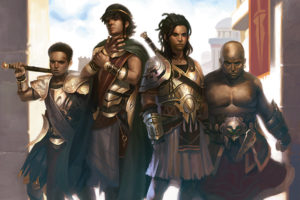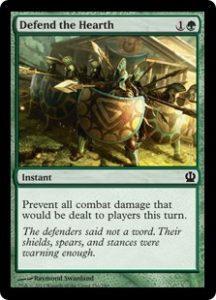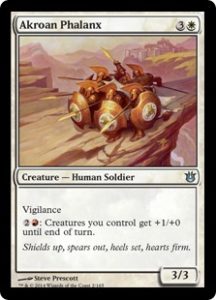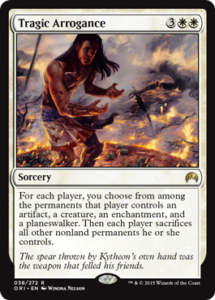This week in Uncharted Realms, we went to jail in Akros to meet Gideon (nee Kytheon) Jura, a Theros native and future defender of Zendikar. After landing behind bars in the “bread theft” ward next to Jean Valjean, Gideon picks a fight with the thugs running the place and eventually earns his release to defend Akros alongside his old friends the Irregulars. From their victory at the gates of the polis to their deaths at the hands of his tragic arrogance, Gideon’s Irregulars are central characters in the backstory of the future planeswalker, leading to the ignition of his spark and his future military exploits in defense of Zendikar and alongside the Boros in Ravnica.
Citizen-Soldiers
Gideon’s vigilante band draws directly from martial tradition in ancient Greek history and culture, like much of the rest of his native plane of Theros. As citizen-soldiers of the polis of Akros, the Irregulars are an example of Greek hoplites, the backbone of classical Hellenic warfare and military history as well as an important element of civic society in the city-states of ancient Greece.
Hoplites were loosely categorized from the mid-Archaic period (800 BCE- 480 BCE) of Greece’s past as citizens of Greek cities mustered into service and capable of affording their own armor and armaments. At first, there was no standardized equipment or strategy for these citizen-soldiers throughout Greece’s cities and colonies in the Mediterranean. Archaeological evidence shows Greek warriors armed with a wide range of weapons throughout the ninth to fifth centuries BCE, all (arguably) evolving towards a single archetype: the armored spearman in block formation.
The Classical period of Greece’s history was a era of tremendous cultural growth as well as military strife. Alongside unrivaled philosophical and architectural achievement, it saw protracted war between Greece and Persia, the Peloponnesian War and subsequent conflicts between leagues of Greek city-states, and the rise of Macedonian power leading to the world conquest of Alexander the Great. During this period, hoplites drawn from the Greek middle and farming classes were mustered into service frequently, and their tactics and armaments went through rapid change and improvement, tested in battle over nearly two centuries. The end result was a tactical formation known as the phalanx, which would come to define Greek warfare and massed infantry tactics for centuries to come.
Fingers of the Army’s Fist
The hoplite phalanx was both the weapon and symbol of the polis at war. Composed of citizen infantry and mobilized in defense of the city, it was a formation which required soldiers to overlap shields and wield long (as much as 18 feet in the Macedonian model) spears overhand in ranks. The end result was a block of massed infantry, protected from missiles by armor and a forest of spears held overhead and impervious to frontal assault thanks to an impenetrable line of speartips, which allowed the front rank to engage enemies before they could close on the formation and the back ranks to fight even without being in hand-to-hand contact with the foe.
This tactical formation proved extremely effective throughout Greece’s wars over the fifth to the third centuries. Persian archers and infantry proved incapable of breaking Athenian Greek phalanxes at the decisive battle of Marathon (490 BCE), leading to a reversal of the Persian wars to date and Greece’s successful repulsion of Persian invasion. More than a century later, Macedonian phalanxes under Philip II and his son Alexander the Great overcame their Greek counterparts (by the simple adaptation of much longer spears) and various foes from Asia Minor to India, holding enemy lines in place before a decisive counter-charge by allied cavalry. Whether facing infantry at Athens, elephants in northern India, or cyclopes at the gates of Akros, an unweakened phalanx was nearly impenetrable against frontal assault.
The hoplite phalanx was both the weapon and symbol of the polis at war.
The real strength of the phalanx, however, and its true importance to Gideon’s past, was the discipline of its individual members. The phalanx was given its name from the Greek word for fingers, phalangos, denoting its role in the Greek military machine. The hoplite infantry of the Greek city-states were the fingers of the army, enacting the will of their commander to close on an enemy force. To prevail, they were expected to obey orders to maintain an unbroken line, acting as cooperative parts of a greater whole.
If one person in the phalanx fell, the gap from their lost shield would lead to their comrades’ deaths. If one block of the phalanx formation broke ranks, the enemy would roll up an entire flank and crush the Greek army. This is largely true for any military formation, but especially true for the classical Greek phalanx. If a Roman legion was broken, its individual members would likely still have peltast javelins, a short gladius sword, and personal armor. A Mongol or Mardu archer would have their horse, bow, and cavalry blade, tools enough to carry on the fight or skirmish and live off the land. Break a Greek phalanx, and its soldiers were left with cumbersome heavy shields and an unwieldy spear twice their height, useless except in formation.
In this way, Gideon’s heroic deeds and tragic hubris are both inspiration and destruction for his Irregulars. As a planeswalker and epic champion, Gideon is in every way the equal of the Archaic heroes of Greek antiquity, the equivalent of Achilles or Hector to his loyal followers. But victory for the phalanx required more than a hero’s deeds. It demanded discipline, careful use of force, and absolute trust in one’s fellow citizen-soldiers in defense of the polis. Gideon’s rash attack upon Erebos, the God of Death showcases his weakness and failure of discipline – rather than a lack of courage, Gideon is plagued by his hubris, the overweening pride that led to the death of his phalanx. As he travels now in defense of Zendikar, both his military background and his tragic overconfidence may define Gideon’s path through the planes and his heroic destiny, far from the phalanx where he learned to fight.





